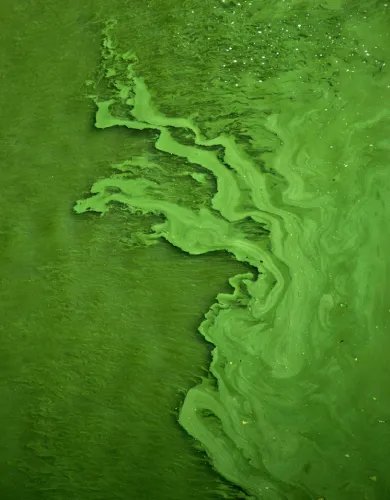Sewage pollution in rivers
“The most recent wastewater discharge data indicates that Thames Water diverted sewage directly into the River Mole for 920 hours in 2023. This is equivalent to 38 days, or almost 10% of the year.”
Over the past decade, the British water industry has been sleepwalking into murky waters. A growing proportion of domestic sewage produced in our towns and cities is not being treated but instead discharged directly into the nearest river.
According to the Environment Agency, there were over 464,000 storm overflow sewage discharges into rivers and seas in 2023 in England alone.
Using the Environment Agency’s historical data and a Freedom of Information request, we explain the evolution of the problem from the perspective of a single Sewage Treatment Works in the Surrey town of Dorking, a textbook example of the pitfalls of privatising essential services.
Contents:
- The role of a sewage treatment works
- The role of a storm overflow system
- The legal basis for dumping sewage into rivers
- Environment Agency consent for sewage discharge
- How often does sewage discharge into rivers happen?
- The consequences of sewage pollution in rivers
- Is dumping sewage into rivers getting worse?
- Underinvestment in the sewage system
- Preventing sewage pollution in rivers
- Planned improvements in sewage infrastructure
Dumping sewage into rivers explained
Dorking is a town in Surrey, located 21 miles south of London.
The River Mole flows through the town and is a tributary of the Thames. It boasts the greatest diversity of fish species in England and has twelve Sites of Special Scientific Interest.
The sewage system in Dorking was first built in 1888 with a Sewage Treatment Works established in Pixham, on the banks of the River Mole. It became the responsibility of Thames Water in 1989 as part of the privatisation of the British water industry.
Approximately 500 metres downstream from the sewage works is the famous stepping stones crossing, a popular bathing spot for hikers who have just tackled Box Hill.

💡 There are 15,000 storm overflow systems in England. We selected this particular sewage work because it directly impacts the article’s principal author, Ben Brading, who often bathes in the river in summer.
The role of sewage treatment works
The Dorking Sewage Treatment Works receives domestic sewage, trade effluent, and surface water drainage from the nearby town.
The facility treats the wastewater using a system of settlement and aeration tanks so that it can be safely returned to the River Mole.
The organic matter (such as faeces) removed from the sewage is converted into renewable business energy and biogas using an anaerobic digester.
The role of a storm overflow system
Like most in the UK, the Dorking Sewage Treatment Works is equipped with a storm overflow system which protects Dorking’s 17,000 residents in the event of heavy rainfall.
When it rains heavily, the volume of wastewater arriving at the Sewage Treatment Works increases significantly. The facility has a limited capacity to treat sewage and, when this capacity is overwhelmed, wastewater is directed into a storm tank to store the sewage for treatment once the rain has subsided.
During extremely heavy rain, if the storm tank becomes full, excess sewage is discharged directly into the nearby River Mole without treatment to prevent sewage from backing up into local homes and businesses.
The legal basis for dumping sewage into rivers
The Water Resources Act of 1991 made it illegal to discharge sewage into British inland waterways, coastal waterways, or groundwater.
However, the law provides an exception where consent is granted by the Environment Agency or Scotland’s Environment Protection Agency.
It might seem strange that these agencies allow the discharge of raw sewage into rivers. However, it is important to remember that in extreme weather, discharging raw sewage into a river is preferable to the alternative of sewage backing up into homes and businesses. Additionally, wastewater during a storm is naturally diluted by the rainwater.
Environment Agency consent for sewage discharge
The Environment Agency granted Thames Water consent to release sewage into the River Mole at the Dorking Sewage Treatment Works under specific conditions.
Using a freedom of information request, we obtained a copy of the consent provided to Thames Water. We’ve extracted the key parts of the consent:
Settled Storm Sewage Consent CASM.1027
From: Dorking Sewage Treatment Works
At: Pixham Lane, Dorking
To: The River Mole
Consent Provided to: Thames Water
The works shall be operated, and the effluent shall be treated in a manner which, so far as reasonably practicable, minimises the polluting effect of the discharge made from the work onto controlled waters.
The consent is given when:
Discharge shall only occur for as long as storm tanks are full. The discharge of storm sewage to the storm tank shall only occur when the rate of flow at the storm separating weir is in excess of 177 litres per second due to rainfall or snow melt.
Storm tanks shall be emptied automatically and their contents returned as soon as practicable after the cessation of the overflow.
Capacity of the storm tank – 1310 cubic meters.
Discharge shall not contain a significant quantity of solid matter greater than 6mm in more than two dimensions.
Source: Environment Agency FoI request.
To put the permit into perspective and more human language, the storm tank’s capacity is about half of an Olympic swimming pool. The permit allows Thames Water to discharge sewage into the River Mole when the site’s treatment capacity is overwhelmed and the storm tank becomes full.
How often does sewage discharge into rivers happen?
The latest Environmental Agency data shows that Thames Water’s sewage works in Dorking discharged sewage into the River Mole on 71 occasions, totalling 920 hours in 2023, under the consent of permit CASM.1027.
For comparison, the previous years reported:
- 2021 – 64 occasions, totalling 612 hours.
- 2022 – 53 occasions, totalling 759 hours
- 2023 – 71 occasions, totalling 920 hours.
Over the last three years, the number of hours of sewage discharge into the River Mole has increased by 50%.
The most recent wastewater discharge data indicates that Thames Water diverted sewage directly into the River Mole for 920 hours in 2023. This is equivalent to 38 days, or almost 10% of the year.
While exact data is hard to come by, it’s clear that it doesn’t rain heavily 10% of the time in Surrey, suggesting that the Dorking Sewage Treatment Works is frequently overwhelmed.
The consequences of sewage pollution in rivers
A recent study by the University of Oxford tested rivers upstream and downstream of sewage discharge points.
The study concluded that untreated sewage discharge results in high levels of nutrients like nitrogen and phosphorus, which encourage the growth of phytoplankton and lead to an explosion in algae (an algal bloom).
These blooms can be lethal for fish populations, as they can monopolise all the sunlight and rapidly overwhelm existing aquatic plants and organisms that the fish rely on for nourishment.
💡Fertiliser pollution in rivers is another contributor to algal blooms.

According to Environment Agencies’ data, the River Mole’s ecological quality score is poor for much of its length.
The organisation River Mole River Watch actively campaigns to return the Mole to a good ecological state for wildlife, plants, and people. The Dorking Sewage Works is just one of ten storm overflow sites on this small river.
Is dumping sewage into rivers getting worse?
While public awareness of sewage dumping into rivers has increased significantly, there is evidence that the problem isn’t new at all.
Before 2018, water companies were only required to measure sewage discharges in “sensitive or high-amenity areas.” A continuous water quality monitoring program was only recently introduced as part of the government’s response to the problem.
On top of this, the population of Dorking has remained relatively stable, having grown by less than 4% over the last decade. This suggests that the worsening situation has little to do with additional strain on the local sewerage system but is instead the result of chronic underinvestment in local sewage infrastructure.
Underinvestment in the sewage system
English water companies are privatised, with domestic and business water rates tightly controlled by the regulator Ofwat.
Without scope to increase revenue, Thames Water and other water companies are incentivised to cut costs as much as possible to create profit for shareholders.
In Dorking, the consent provided by the Environment Agency has made dumping sewage into the River Mole legal. With it, Thames Water can delay investment in additional capacity required at the sewage works and deliver short-term value.
This is supported by a recent paper from Imperial College London, which concludes that sewage spills result from a lack of infrastructure development rather than unpredictable weather patterns.
💡Analysis from the BBC also found evidence of dry spills in 2022 from Wessex Water, Southern Water and Thames Water. An Ofwat investigation is underway to determine whether water companies broke the conditions of their storm overflow permits.
Preventing sewage pollution in rivers
Although sewage discharge into rivers has been a steadily growing problem, the release of water quality data to the public has brought media attention to the issue.
A national consumer survey in 2023 by River Action revealed a surge in public concern over the dire state of Britain’s rivers and waterways.
This demand for action occurs in the context of wider issues within the water industry, including significant uncertainty about the ability of Thames Water to remain solvent.
Plans to reduce sewage discharge into rivers
In 2022, the UK government published its Storm Overflow Discharge Reduction Plan.
The plan aims to reduce storm overflow discharges by 25% by 2025 and eliminate sewage discharges outside of unusually heavy rainfall events by 2050.
It also strengthens monitoring requirements for water companies to ensure a clear understanding of the impact of storm overflows.
To discourage sewage discharge into rivers, the government will compel water companies to meet these new standards. Unfortunately, the funds for infrastructure improvements will come from increases in water bills, putting further pressure on taxpayers.
Funding upgrades to sewage systems
In the water market, all investments made by private water companies require approval from Ofwat, the industry regulator.
Ofwat reviews all water company investment proposals every five years to ensure they deliver value for money and benefit the environment.
In its most recent review in 2019, Ofwat vetoed 30% of the proposed investment. This strict control over water bills has been linked to the fact that the UK hasn’t built a new reservoir since 1991, despite a growing population and increasing problems related to water scarcity.
Ofwat’s upcoming investment review for 2025 to 2030 is expected to address the lack of investment in sewage infrastructure.
To provide a more immediate impact, Ofwat has approved an additional expenditure of £1.6 billion to address sewage discharge from storm overflows, to be spent between 2023 and 2025.
Upgrading the sewerage systems to protect rivers
The Thames Water website indicates plans to spend £1.12 billion on sewage treatment works upgrades over the next two years.
As part of this initiative, the Dorking Sewage Treatment Works is undergoing a £14 million upgrade. The planned upgrade will increase treatment capacity and the size of storm tanks to reduce the frequency of untreated sewage discharges.
In 2023, Water UK, the trade association for the industry, announced a £10 billion plan for the modernisation of sewers, scheduled for expenditure between 2025 and 2029. This plan is pending approval by Ofwat.
The investment required to eliminate sewage discharge is substantial and will likely lead to significant increases in home and business water bills in the coming years.

